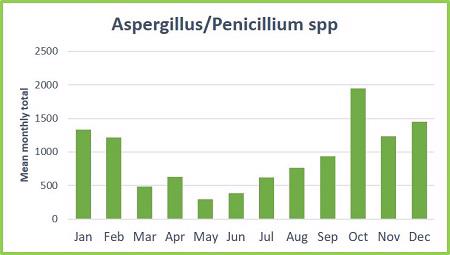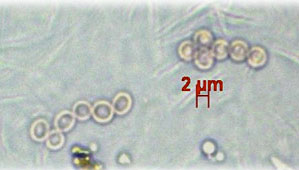Good air quality is important for everyone’s health. However, those with lung conditions, such as aspergillosis and asthma, may be more vulnerable to the effects of poor air than others. Airborne pollutants and allergens are found both indoors and outdoors, and can irritate our lungs and exacerbate existing conditions. It can be useful, therefore, to know when and where these irritants are at their most harmful concentrations — this can allow us to understand, avoid and prevent any harmful air conditions that may be affecting our health. Here we have compiled a selection of air quality forecasts and information:
Fungal Spores
Fungal spores are microscopic particles responsible for the reproduction of fungi. We inhale huge numbers of these particles in each breath — for most people, this doesn’t affect their health. However, some individuals, including aspergillosis patients, are more susceptible to allergic reactions and infections from mould spores. It can therefore be useful to know when mould spores are at their highest concentrations, in order to reduce exposure to them. We are currently entering peak spore season for most moulds (June – August). Peak spore season coincides with hayfever season, and allergies to pollen and spores carry similar symptoms (runny nose, sore eyes, rashes). Therefore, it is often difficult to distinguish between these conditions, and medical tests may be necessary.
The National Pollen and Aerobiology Research Unit at the University of Worcester has produced a number of helpful calendars, showing the monthly spore count averages over a period of 5 years. They have also compiled useful information on the allergenicity of each spore type and where each mould prefers to grow. This allows those at risk to avoid areas where the spore concentration is potentially very high. The information for Aspergillus/Penicillium spp. is copied below:
The year starts with a high risk for these types with a total monthly average of 1,333 (per m3) spores in January and 1,215 in February. Spores continue to be airborne during Spring and early Summer but possibly below the levels needed to trigger symptoms. From mid-August the risk starts to rise again and people often report symptoms during warm, humid conditions in late August, September and October, with the peak reaching an average of 1,950 spores in October. Although the spore levels continue to be high during November and December, few people report symptoms, so it is likely that the types occurring during these months are less allergenic.
Habitat / Substrates:
There are many species of Aspergillus and Penicillium, which live on a wide range of substrates. The spores can be very prevalent during the peak periods, triggering a range of respiratory problems. The spores are particularly prevalent in wooded areas, compost heaps, rotting wood chips and bark mulch. Some species rot down pine needles, so conifer plantations should be avoided during Autumn. Penicillium chrysogenum is found widely in nature, occurs on indoor substrates and is the type used to produce the antibiotic penicillin. N.B. Houseplants can be sources of spores, particularly Aspergillus/Penicillium types. If you’re keen to have houseplants, only have cacti, which require dry conditions, and ensure the soil surface is covered in grit.
Season:
Aspergillus and Penicillium spores are present in the air throughout the year but the main peak periods are late August to October and January to February.
Allergenicity:
High for some types, particularly A. fumigatus and P. chrysogenum. A. fumigatus is a major cause of aspergillosis (farmer’s lung).
For spore forecasts and information about other species:
For regular updates on pollen and spore counts:
- The Midlands Asthma and Allergy Research Association (UK)
- National Pollen and Aerobiology Research Unit (UK)
- The Asthma Center (US)
Indoor air
Those self-isolating due to COVID-19 are spending almost all of their time at home. Therefore, indoor air quality is more of a concern than ever. Over the past ~50 years, our homes have become far more insulated. While this stops drafts and keeps our homes warmer, it also means than our living spaces are generally damper and less ventilated. This can provide ideal conditions for mould to grow and thrive. There are a number of small things that we can do to prevent mould and damp: these include drying laundry outside (if possible), fixing leaks and using lids when cooking. It is also important to identify and remove any mould in your living space, in order to prevent it from spreading. A selection of articles on indoor air quality and instructions for how to safely remove mould are listed below.
For more information:
- Damp homes
- Indoor air pollution
- Dehumidifiers
- Air conditioning units
- Anti-allergen products
- How do I… find the source of the damp?
- How do I… remove mould from my washing machine?
- How do I… make my private landlord fix my damp home?
- How do I… make the council fix my damp home?
- How do I… keep my home dry?
Pollution

Air pollution is a significant health concern, especially for those living with existing lung conditions. This is a particular issue in urban areas, where the sources of pollutants are concentrated. Weather also influences levels of pollution, with stiller conditions often worsening the issue. It can therefore be useful to access pollution forecasts, so that high levels can be avoided, where possible.
Regularly-updated pollution forecasts for the UK and worldwide:
For further information on air quality:
Share this post
Latest News posts
How do I get vaccinated?
September 20, 2018
How do I do a disability assessment?
September 14, 2018
How do I keep my home dry?
September 14, 2018
How do I find the source of the damp?
September 14, 2018
How do I buy a face mask?
August 23, 2018
How do I report drug side effects?
August 17, 2018
How do I make the council fix my damp home?
August 17, 2018
How do I make my private landlord fix my damp home?
August 17, 2018
How do try a new diet?
August 17, 2018
How do I loosen and clear mucus?
August 16, 2018
News archive
- Antifungals in development
- COVID-19
- Events
- Fundraising
- General interest
- How do I...?
- Information and Learning
- Latest research news
- Lifestyle and Coping Skills
- Living with Aspergillosis
- NAC announcements
- News archive
- Patient and Carer Blog
- Patient stories
- Recordings
- Supplements and complementary therapies
- Types of aspergillosis
- Video


